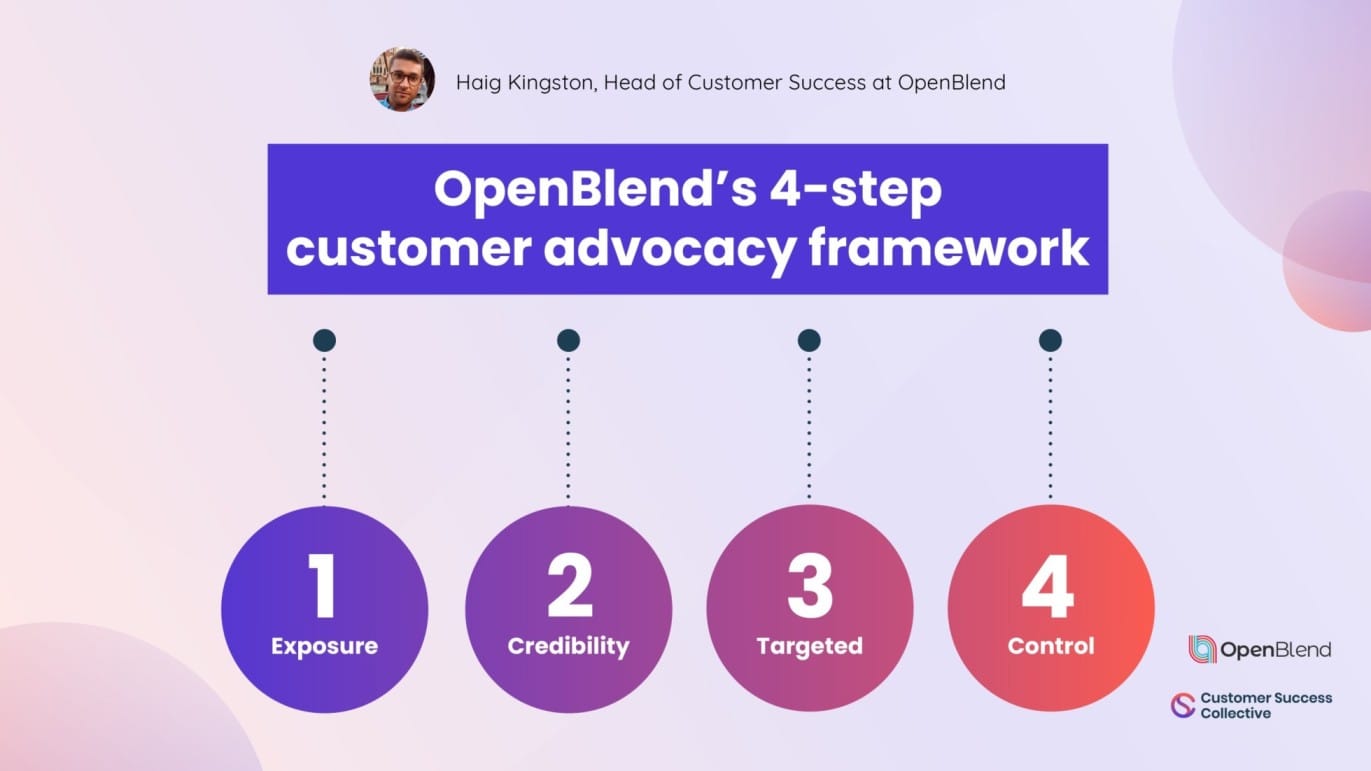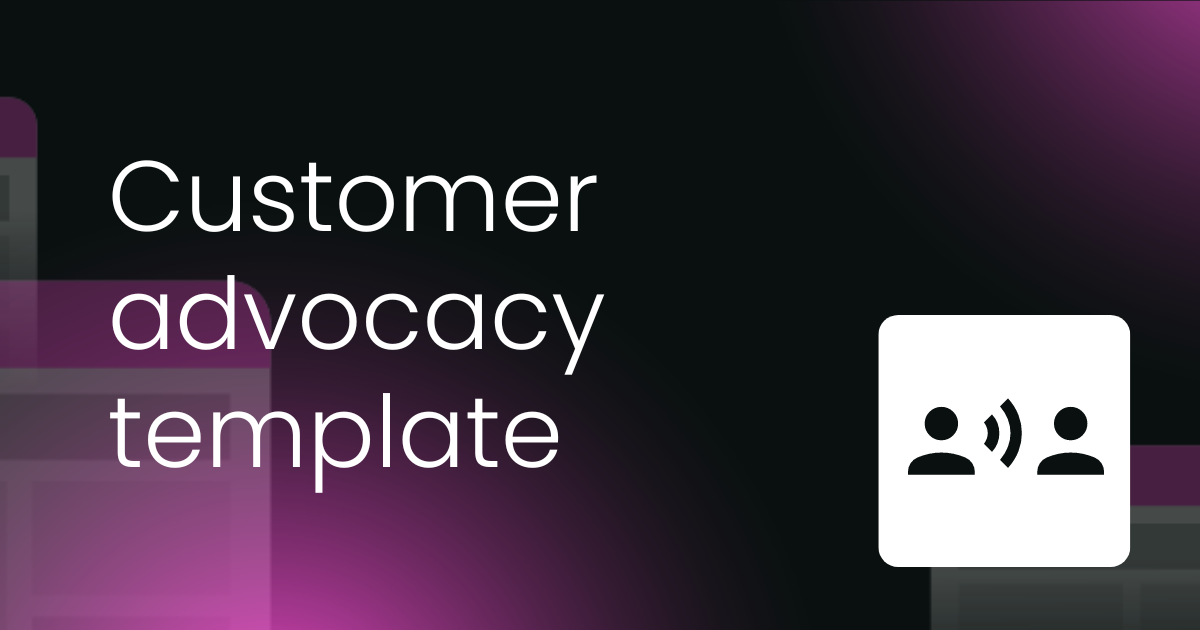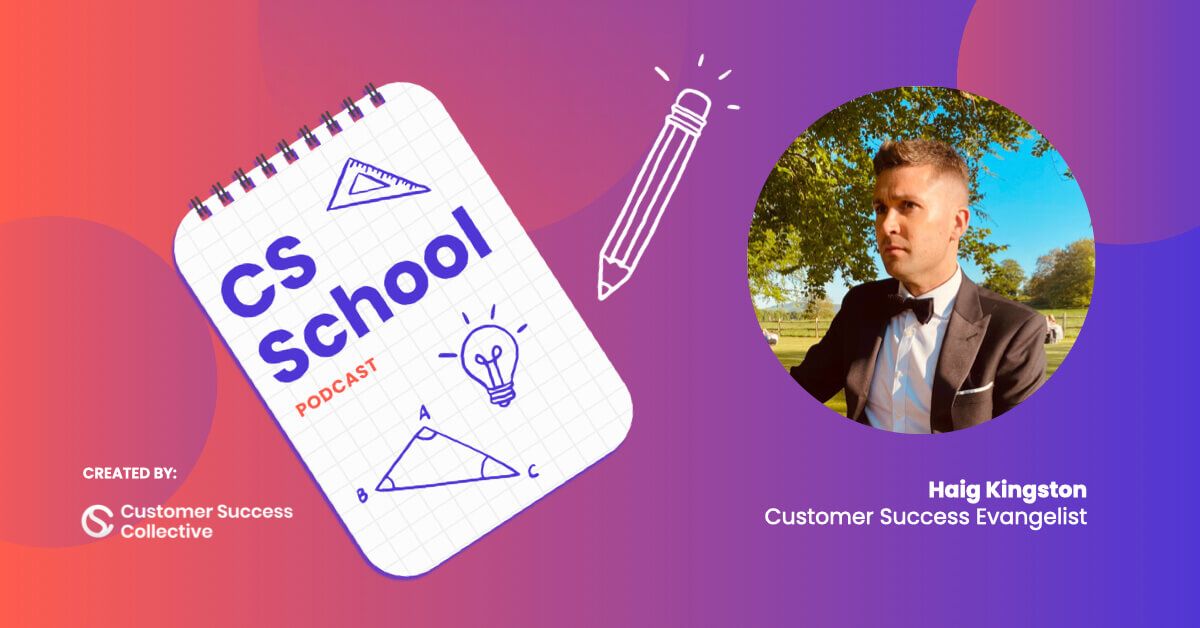When it comes to customer advocacy, there’s a very necessary shift that needs to happen. Too often, we approach advocacy completely in the wrong way. Advocacy can often feel very one-sided, with very little benefit for the customer. But we need to radically rethink the way we tackle advocacy programs – swapping passive interactions for dynamic partnerships.
This mentality shift is both complex and rewarding; it involves crafting strategies that not only meet but exceed the expectations of our customers, ensuring their success is at the heart of everything we do. Advocacy isn’t just a badge you slap on a reasonably-satisfied customer – that’s sloppy and unsustainable. True advocacy needs to benefit the customer, too.
At OpenBlend, we’ve refined our approach to customer advocacy by developing a framework that empowers customers and aligns their achievements with our organizational goals.
In this article, I’m going to reveal the techniques and insights that have shaped our customer advocacy efforts, turning routine engagements into robust, mutually beneficial partnerships.
Keep reading to learn about:
- How we developed a customer advocacy framework at OpenBlend
- The shift to a partnership approach
- Visualizing genuine partnerships
- Communicating the benefits of advocacy
- How OpenBlend's customer advocacy framework works
- The impacts and benefits of customer-led advocacy
- Practical advice for structuring customer advocacy programs
Developing a customer advocacy framework at OpenBlend
I’ve had the privilege over the course of my career to work in a variety of customer-centric, which, have in turn, underscored the significance of truly understanding and responding to the unique needs of each customer.
That said, advocacy is something many businesses often don’t get quite right, which, in my opinion, when considering the current marketplace, is a huge missed opportunity.
At OpenBlend, we approach customer advocacy with a strong emphasis on personalized engagement and value. I developed our current framework just before Christmas 2023, as I anticipated that advocacy would become a crucial element in both team and customer performance moving into 2024.
This framework is designed to empower customer advocates by offering them complete control over their involvement. They can choose the type of activities they want to participate in, which aligns with our philosophy of partnership and putting the customer at the center of their own success story. Our CS team is dedicated to helping bring these success stories to life.
Our customer advocacy in a nutshell
The framework consists of four quadrants:
- Exposure
- Credibility
- Targeted
- Control
This structure was inspired by strategies I observed in previous roles and businesses. It helps us identify potential advocates and tailor our approach to meet their specific needs. We discuss with them the different processes and outcomes they can expect, depending on their choices.
Our aim is to not only highlight these customer stories for our own promotional efforts but also to enhance the visibility of the work our customers do within their own organizations. This holistic approach ensures that advocacy is both meaningful and rewarding for all parties involved.
The shift to a partnership approach
In the wider world of subscription services, software-as-a-service (SaaS), and even, to an extent, customer service, there’s a palpable power shift back to the customer. In fact, it’s totally transformed traditional business relationships. This shift is crucial in framing your understanding of customer advocacy, especially given that traditionally speaking engagement can often be a significant challenge.
I think it’s fair to say that, traditionally speaking, advocacy has been perceived as pretty one-directional. It’s often viewed in terms of “company-asks-customer-for-favor,” like requesting a customer to write a case study and leaving it at that. That’s not to say we shouldn’t be asking for case studies, but if there’s no real benefit for the customer, no real value for them, it can lead to disengagement.
In contrast, the framework I designed at OpenBlend places the customer at the forefront, giving them significant control over their participation. We guide them through the advocacy process, ensuring they understand the benefits and have the power to decide how they wish to engage.
Advocacy isn’t one-size-fits-all
Not every customer advocate will be able to contribute in the same way.
For example, legal constraints might prevent some customers from allowing their logos on our website or discussing their use of our services in a case study. Our framework accommodates these limitations, offering various ways customers can engage without compromising their brand guidelines or legal obligations.
Conversely, some organizations and individuals are eager to promote themselves and share industry best practices. Our approach caters to these varying needs and desires.
The key to successful advocacy programs is to move away from the outdated "favor" model and instead focus on a partnership model. We aim to make advocacy mutually beneficial, aligning it with the customer's goals and providing them with a platform to showcase their achievements. This ensures that our interactions with customers are proactive and valuable, enhancing their overall journey and relationship with us.
Visualizing true partnership in customer advocacy
Customer advocacy isn't just about obtaining testimonials or case studies; it's fundamentally about highlighting and promoting the customer's success. This perspective shift from a favor-based model to a genuine partnership is key.
When explaining this partnership to customers, particularly those who might be hesitant, I emphasize the direct benefits to them. It's not just about displaying their brand on our site; it's about the comprehensive value they, their team, and their individual employees receive from the engagement.
Communicating the benefits of advocacy
We categorize the benefits of our advocacy framework into three main areas:
- Brand
- Team
- Individual
For the brand, participating in advocacy positions the company as a thought leader and showcases its successes, helping it stand out in its industry.
For the team, it's an opportunity to highlight their expertise, share best practices, and connect with peers facing similar challenges. For individuals, it boosts their personal brand within and outside their organization, enhancing their professional network and visibility.
Our approach at OpenBlend is strategic and customer-centric. We break down what "value" means in specific, actionable terms that resonate with our customers' goals.
For instance, some of our clients leverage the framework to enhance their employer value proposition, using it as a tool to retain and attract top talent by showcasing their company as a great place to work.
This strategic focus ensures that every aspect of our advocacy efforts is designed to benefit the customer, fostering a partnership that is both productive and mutually beneficial.
How OpenBlend's customer advocacy frameworks work
The advocacy framework we've developed at OpenBlend centers around four key quadrants: exposure, credibility, targeting, and control. These quadrants help guide our approach to customer advocacy, ensuring it aligns with both our goals and those of our customers.

Each quadrant represents a different aspect of advocacy and offers various levels of engagement based on the customer's preferences and legal constraints. As I mentioned earlier, some customers may face legal restrictions that prevent them from being publicly named, which makes options like peer-to-peer calls more suitable for them as these provide greater control and are highly targeted.
On the other hand, customers seeking high exposure and credibility might opt for more visible activities such as participating in live events or webinars. These platforms allow them to lead discussions and share valuable insights, establishing them as thought leaders within their industry.
The framework's design allows us to break down our advocacy activities —such as quotations on our website, customer blogs, logo placements, or case studies— into these four categories.
This structured approach helps us visually communicate to customers how they can engage with us while encouraging them to inform us if they see a better fit for their needs.
For those planning their own advocacy programs, the key is to clearly identify what works best in your existing processes and strategically position these within a customer-oriented framework. This ensures that the advocacy efforts are not only effective but also genuinely appreciated and valued by the customers, fostering a stronger, more beneficial partnership.
The impact and benefits of customer-led advocacy
Customer referrals stand out as the most significant benefit of effective customer advocacy. There's nothing quite as powerful as having your current customers act as references for prospective new clients or aiding in the growth of contracts with existing customers. This peer endorsement is especially impactful because it comes from like-minded individuals who share relatable experiences.
In my observation, especially this year and looking ahead to 2025, customer-led referrals are set to be the cornerstone of advocacy efforts. The role that CS teams play in fostering these referrals could indeed be transformative for the industry. This change could redefine how CS's contributions are perceived and measured, potentially revolutionizing the field.
From my experience, especially at OpenBlend, we've seen that our business thrives on customer referrals. Measuring the effectiveness of these referrals involves not only tracking the direct mentions by new clients about how they heard about us but also recognizing the broader influence our existing customers have through their participation in industry events and other public endorsements.
This aspect of customer advocacy – its ability to generate referrals and enhance brand credibility – might not currently receive the spotlight it deserves. It's crucial for CS teams to understand and leverage the power of customer advocacy not just as a function of their job, but as a strategic element that significantly impacts business growth.
This shift in focus could elevate the importance of advocacy within organizations, highlighting it as a key driver of sustainable growth.
Practical advice for structuring customer advocacy programs
For customer success teams looking to enhance their advocacy programs, moving away from the ad-hoc, favor-based requests is crucial. It's about creating a more structured, formal approach that centers around the customer's needs and preferences.
One practical step is to step outside the traditional “favor” mindset and instead, engage deeply with customers, giving them the flexibility to choose how they wish to participate. This not only empowers them but also aligns their involvement with their own goals, making the advocacy more effective and meaningful.
At OpenBlend, our framework brings customers into the planning process. This allows us to track advocacy efforts more closely and tailor our approach to ensure it resonates with the customers’ objectives. And the key here is to be specific about the outcomes you're aiming for and to give customers complete control over their stories.
Breaking down the process clearly – explaining what is being done, why it's being done, how it will be done, and where it will take place – is essential for transparency and builds trust. It's also important to continually seek feedback from customers on this framework, which helps refine and improve the approach based on real-world input and experiences.
To make advocacy programs more structured and impactful, customer success teams should focus on customer-centric strategies, clear communication, and continual learning and adaptation based on customer feedback. This shift from an outdated approach to a dynamic, involved strategy is what will truly make customer advocacy programs successful.
TL;DR?
- There’s a real need to shift from one-sided to mutually beneficial customer advocacy
- OpenBlend developed a 4-quadrant framework: exposure, credibility, targeting, control
- Proactive advocacy empowers customers to choose advocacy activities that align with their goals
- Customer success teams need to move away from the traditional "favor" model to a partnership approach
- Practical advice:
- Involve customers in advocacy planning
- Ensure transparency and continuous feedback
- Adapt advocacy program based on customer needs
This article was adapted from Haig’s appearance on the CS School podcast.
Keep on learning
If you enjoyed this article, and want to learn more about customer advocacy, then why not sign up for our Customer Advocacy Certified: Masters program?
🧠 Learn the fundamentals and exact blueprint for creating highly engaging customer advocacy programs
🧰 Leverage your advocacy toolbox to help you scale and avoid potential pitfalls before launching your programs
💡 Understand how to align your customer engagement initiatives to strategic drivers within your organization
📐 Successfully measure your program ROI to get more budget and headcount



 Follow us on LinkedIn
Follow us on LinkedIn










